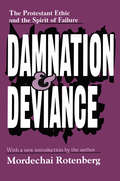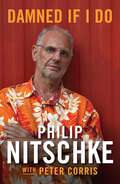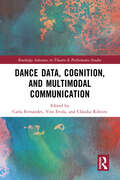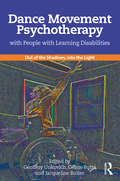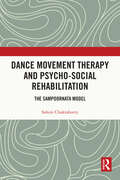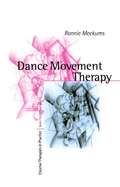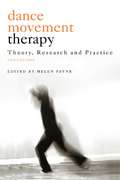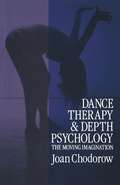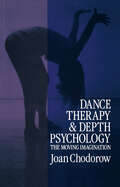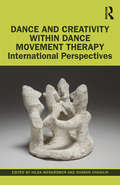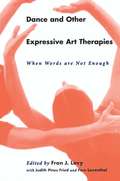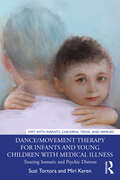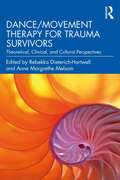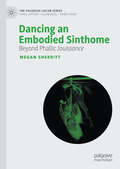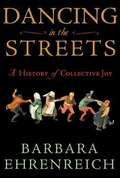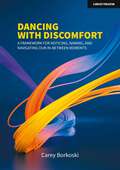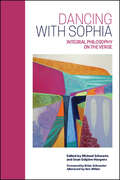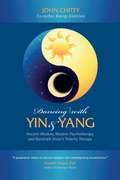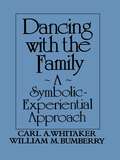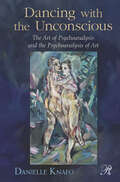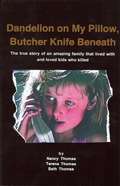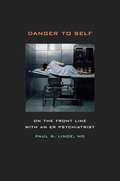- Table View
- List View
Damnation and Deviance: The Protestant Ethic and the Spirit of Failure
by Mordechai RotenbergThe Calvinist view that man is predestined to be among the elect or the damned has profoundly influenced not only our views of criminals and deviants, but also the theoretical basis of correctional methods and psychotherapeutic techniques. In this provocative and original volume, Mordechai Rotenberg examines the impact of Protestant doctrine on Western theories of deviance. He explores the inherent contradiction between Protestant ethics, with its view of human nature as predestinated, and the "people-changing" sciences.Rotenberg presents empirical studies that show how people's tendency to label themselves and others as deviant can be predicted on the basis of their exposure to Western socialization. He contrasts alienating individuals, the result of competitiveness and exaggerated independence fostered by socialization in Protestant societies, to the reciprocal individualism of Hassidic, Japanese, and other non-Western cultures. Examining the Protestant "bias" of Western behavioral sciences, Rotenberg examines modern theories of deviance and proposes alternative models. He compares traditional past-oriented insight therapy, grounded in Calvinist methods of introspection, self-torment, and conversion, with Hassidic notions of redemption and salvation."Rotenberg provides important historical and sociological insights into the intellectual origins of modern theories of deviance. His argument that Western behavioral science retains a Calvinist view of humanity will force most scholars to examine anew the assumptions and foundations of their own theories."--Gerald N. Grob, Rutgers University"A highly original work, which should be of great interest to anyone concerned with relevant behavior. It shows how macro-definitions in a society tend to lead people to think about themselves and their ills in certain ways--and thus to deviate in certain ways."--Richard A. Cloward, co-author, Regulating the Poor: The Functions of Public Welfare
Damned if I do
by Peter Corris Philip NitschkeThis is the revealing, personal story of the man behind the controversial pro-euthanasia movement, told in his own words. Medical doctor, humanist, author and founder/director of Exit International, Philip Nitschke's life has always been in the spotlight. The books spans Philip's early days, from his curious, activist student days in Adelaide, to working with Aboriginal land rights groups in Australia's Far North; to his successful campaign to have euthanasia legalised in Australia and his assistance in four people ending their lives before the law was overturned. It covers the controversy surrounding Philip's work, including the banning in Australia of his international bestselling book The Peaceful Pill, and disturbing reports that many young people overdosed on Nembutal, the drug that Exit International recommends for suicide. Ultimately, Philip believes that the right to one's own death is as fundamental as the right to control one's own life: 'It seems we demand humans to live with indignity, pain and anguish whereas we are kinder to our pets when their suffering becomes too much.'
Dance Data, Cognition, and Multimodal Communication (Routledge Advances in Theatre & Performance Studies)
by Carla Fernandes Vito Evola Cláudia RibeiroDance Data, Cognition, and Multimodal Communication is the result of a collaborative and transdisciplinary effort towards a first definition of "dance data", with its complexities and contradictions, in a time where cognitive science is growing in parallel to the need of a renewed awareness of the body’s agency in our manyfold interactions with the world. It is a reflection on the observation of bodily movements in artistic settings, and one that views human social interactions, multimodal communication, and cognitive processes through a different lens—that of the close collaboration between performing artists, designers, and scholars. This collection focuses simultaneously on methods and technologies for creating, documenting, or representing dance data. The editors highlight works focusing on the dancers’ embodied minds, including research using neural, cognitive, behavioural, and linguistic data in the context of dance composition processes. Each chapter deals with dance data from an interdisciplinary perspective, presenting theoretical and methodological discussions emerging from empirical studies, as well as more experimental ones. The book, which includes digital Support Material on the volume's Routledge website, will be of great interest to students and scholars in contemporary dance, neuro-cognitive science, intangible cultural heritage, performing arts, cognitive linguistics, embodiment, design, new media, and creativity studies.
Dance Movement Psychotherapy with People with Learning Disabilities: Out Of The Shadows, Into The Light
by Céline Butté Jacqueline Butler Geoffery UnkovichThis book provides an overview of dance movement psychotherapy for young people and adults with learning disabilities. Contributors from a variety of backgrounds examine their work with clients from across the disabilities spectrum, ranging from mild to complex needs. The book chapters present theory and practice relating to the client group and subsequent therapy processes. This comprises psychotherapeutic interventions, dance movement interventions, theoretical constructs, case study material, practitioner care, and practitioner learning and development related to individual and group therapy work. The logistics of a Dance Movement Psychotherapy intervention, the intervention itself and the ripples of influence into the clients’ wider socio-cultural context are discussed. This stance speaks to current research and practice discourse in health and social care. The book champions acceptance of difference and equality in the health and social care needs for people with learning disabilities whilst emphasising the importance of dance movement psychotherapy for people with non-verbal communication. Dance Movement Psychotherapy with People with Learning Disabilities: Out of the Shadows, into the Light will provide a practical and theoretical resource for practitioners and students of dance movement psychotherapy as well as allied health professionals, service providers and carers.
Dance Movement Therapy and Psycho-social Rehabilitation: The Sampoornata Model
by Sohini ChakrabortyThis book looks at the psychotherapeutic effects of Dance Movement Therapy (DMT) with a focus on the experiences of survivors of gender-based violence and their social development, psycho-social rehabilitation, and reintegration within society. The author, a sociologist and dancer, uses a model she calls Sampoornata— or Fulfilment, to merge sociology and dance in order to help survivors of sexual violence overcome their trauma. Sampoornata was developed to help survivors of gender-based violence and trafficking, by focusing on their specific needs, and helping them to express themselves and overcome emotional and psychological pain. Through interviews with and detailed narratives of survivors, the book takes the readers through the development of the model, its implementation, practice, and impact on their lives. Situated within the social, cultural, as well as geographical context of India, the book is an important resource for rethinking the creative approaches, theories, and practice of DMT worldwide. This book will be of interest to researchers and students of psychology, psychotherapy, dance and movement studies, and to those who work with dance and movement therapy. It will also be useful for professionals working in the areas of gender violence, trafficking, trauma, psycho-social rehabilitation, and well-being.
Dance Movement Therapy: A Creative Psychotherapeutic Approach (Creative Therapies in Practice series)
by Bonnie Meekums`This book is a very useful starting point for trainees in DMT, or for those training or practicing in other arts therapies or allied professions who would like an overview of theories and methods in DMT. For more experienced DMT practitioners and researchers, this book provides an introduction to theories of creativity and the notion of the movement metaphor as a basis for DMT theory and practice. There is constant dialogue and contextualizing between Meekum′s theory and approach, psychological theories that have influenced the development of DMT, case studies, and the historical development of DMT. What is important in this book is the acknowledgement that DMT is a unique psychotherapy practice with a distinctive theory and methodology based on the intrinsic interaction between movement, the creative process, and psychology′ - Body, Movement and Dance in Psychotherapy `Along with the "how" and "why" of psychotherapy, Bonnie Meekums provides realistic examples of people whose lives have benefited from dance movement therapy. It is my honour to recommend this book′ - Dianne Dulicai, President of the American Dance Therapy Association `It is a very accessible book - it′s an introduction to Dance Movement Therapy, ideal for students who have started DMT training, people who work in related fields (eg other arts therapies) or anyone who is interested in DMT. However, the book goes beyond the introduction in Bonnie′s attempt to develop a new framework. It encourages practising DMTs to question their own approach introducing a different terminology to describe the creative process…. It is food for thought and for discussions in supervision′ - e-motion `Dr Meekums surpasses her goal of contributing to the development of DMT; her book serves as a catalyzing guide for all health care professionals who seek creative processes in healing…. Meekums provides an innovative framework for DMT, and offers adequate references and recommendations for further study, research and evidence-based practice. I enthusiastically recommend this book to creative arts therapists, allied practitioners and especially to practicing and interning dance movement therapists as a professional resource and guide′ - Maria Brignola Lee, The Arts in Psychotherapy Dance Movement Therapy is a concise, practical introduction to a form of therapy, which has the body-mind relationship at its centre. Movement, with both its physical and metaphorical potential, provides a unique medium through which clients can find expression, reach new interpretations and ultimately achieve a greater integration of their emotional and physical experience. In the book, Bonnie Meekums maps the origins of Dance Movement Therapy (DMT) and its relationship to other more traditional forms of therapy. Outlining a new model for DMT, she describes the creative process, which develops in cycles throughout each session and over the course of therapy. The stages in this creative, psychotherapeutic process are described as: - preparation - incubation - illumination - and evaluation Illustrated throughout with vivid case examples, the book defines the role of the therapist in working with clients to bring about change. This is a practical and accessible guide, which will help new trainees become orientated within the field of DMT. It also has much to offer practising psychotherapists who wish to develop more holistic and creative ways of meeting their clients′ needs.
Dance Movement Therapy: Theory, Research and Practice
by Helen PayneWhat can dance movement contribute to psychotherapy? This thoroughly updated edition of Dance Movement Therapy echoes the increased world-wide interest in dance movement therapy and makes a strong contribution to the emerging awareness of the nature of embodiment in psychotherapy. Recent research is incorporated, along with developments in theory and practice, to provide a comprehensive overview of this fast-growing field. Helen Payne brings together contributions from experts in the field to offer the reader a valuable insight into the theory and practice of Dance Movement Therapy. The contributions reflect the breadth of developing approaches, covering subjects including: dance movement therapy with people with dementia group work with people with enduring mental health difficulties transcultural competence in dance movement therapy freudian thought applied to authentic movement embodiment in dance movement therapy training and practice personal development through dance movement therapy. Dance Movement Therapy will be a valuable resource for anyone who wishes to learn more about the therapeutic use of creative movement and dance. It will be welcomed by students and practitioners in the arts therapies, psychotherapy, counselling and other health and social care professions.
Dance Therapy and Depth Psychology: The Moving Imagination
by Joan ChodorowAn historical overview of Jung's basic concepts is given as well as the most recent depth psychological synthesis of affect theory based on the work of Sylvan Tomkins, Louis Stewart, and others. Finally in discussing the use of dance/movement as active imagination in practice, the movement themes that emerge and the non-verbal expressive aspects of the therapaeutic relationship are described.
Dance Therapy and Depth Psychology: The Moving Imagination
by Joan ChodorowDance/movement as active imagination was originated by Jung in 1916. Developed in the 1960s by dance therapy pioneer Mary Whitehouse, it is today both an approach to dance therapy as well as a form of active imagination in analysis. In her delightful book Joan Chodorow provides an introduction to the origins, theory and practice of dance/movement as active imagination.Beginning with her own story the author shows how dance/ movement is of value to psychotherapy. An historical overview of Jung's basic concepts is given as well as the most recent depth psychological synthesis of affect theory based on the work of Sylvan Tomkins, Louis Stewart, and others. Finally in discussing the use of dance/movement as active imagination in practice, the movement themes that emerge and the non-verbal expressive aspects of the therapaeutic relationship are described.
Dance and Creativity within Dance Movement Therapy: International Perspectives
by Hilda Wengrower; Sharon ChaiklinDance and Creativity within Dance Movement Therapy discusses the core work and basic concepts in dance movement therapy (DMT), focusing on the centrality of dance, the creative process and their aesthetic-psychological implications in the practice of the profession for both patients and therapists. Based on interdisciplinary and multidisciplinary inputs from fields such as philosophy, anthropology and dance, contributions examine the issues presented by cultural differences in DMT through the input of practitioners from several diverse countries. Chapters blend theory and case studies with personal, intimate reflections to support critical descriptions of DMT interventions and share methods to help structure practice and facilitate communication between professionals and researchers. The book’s multicultural, multidisciplinary examination of the essence of dance and its countless healing purposes will give readers new insights into the value and functions of dance both in and out of therapy.
Dance and Other Expressive Art Therapies: When Words Are Not Enough
by Fran J. Levy Judith Pines Fried Fern LeventhalFirst published in 1996. Routledge is an imprint of Taylor & Francis, an informa company.
Dance with the Devil: A Memoir of Murder and Loss
by David BagbyImmortalized in the acclaimed documentary Dear Zachary, this brutally honest memoir chronicles a system&’s failure to prevent the murder of a child. In November 2001, the bullet-riddled body of a young doctor named Andrew Bagby was discovered in Keystone State Park outside Latrobe, Pennsylvania. For parents Dave and Kate, the pain was unbearable—but Andrew&’s murder was only the beginning of the tragedy they endured. The chief suspect for Andrew&’s murder was his ex-girlfriend Shirley Turner. Obsessive and unstable, Shirley lied to police and fled to Newfoundland before she could be arrested. While fending off extradition efforts by U.S. law enforcement, she announced she was pregnant with Andrew's son, Zachary. Hoping to gain custody of the child, the Bagbys moved to Newfoundland. They began a drawn-out court battle to protect their grandson from the woman who had almost certainly murdered their son. Then, in August 2003, Shirley killed herself and the one-year-old Zachary by jumping into the Atlantic Ocean. Dance with the Devil is David Bagby&’s eulogy for a dead son, an elegy for lives cut tragically short, and a castigation of a broken system.&“[An] incendiary cri de coeur.&”—The New York Times DANCE WITH THE DEVIL is a eulogy for a dead son, an elegy for lives cut tragically short, and a castigation of a broken system.
Dance/Movement Therapy and Sexual Abuse: Assessment and Intervention Based on Body-Mind Approaches
by Einat Shuper EngelhardDance/Movement Therapy and Sexual Abuse addresses the vital role dance/movement therapy plays in helping survivors of sexual abuse. Comprising ten chapters, the book describes assessment, diagnosis and intervention techniques with child, adolescent, and adult survivors of sexual abuse. Using case studies, contributing experts in the field offer the reader a profound understanding of the therapeutic techniques related to movement and the body for the emotional treatment of situations of sexual abuse. The chapters delve into the healing components of treatment during childhood, adolescence, and adulthood, and combine psychodynamic understandings with body-mind theories, techniques from the area of somatic experience, and bio-energetic analysis. Full of in-depth and comprehensive therapeutic interventions using dance/movement therapy to treat sexual trauma, this book will be an essential resource for dance/movement therapists and students of the creative arts therapies.
Dance/Movement Therapy for Infants and Young Children with Medical Illness: Treating Somatic and Psychic Distress (DMT with Infants, Children, Teens, and Families)
by Suzi Tortora Miri KerenThis book presents dance/movement therapy as a window into the emotional and internal experience of a baby with a medical illness, within the context of treating the whole family system and using the DC 0-5 as the basis for formulating the clinical situation. This book fills a gap in the literature, bringing a variety of fields together including infant mental health, infant and child psychiatry, nonverbal-movement analysis, and the creative arts therapies. Grounded in a biopsychosocial perspective, dance/movement therapy is introduced as the main treatment modality, using nonverbal expression as a means of communication, and dance and music activities as intervention tools, to support the child and family. Vignettes from both during and years after the medical experience are presented throughout the book, taking into consideration the subtle and more obvious effects of illness on the child’s later emotional, social, and behavioral development. They illustrate the expertise of the authors as infant mental health professionals, drawing upon their work in hospitals and private practices, and highlight their unique perspectives and years of collaboration. This exciting new book is essential reading for clinicians and mental health professionals working with infants and their families.
Dance/Movement Therapy for Trauma Survivors: Theoretical, Clinical, and Cultural Perspectives
by Rebekka Dieterich-HartwellThis book offers a timely, detailed, and comprehensive synopsis of dance/movement therapy (DMT) in the treatment of psychological trauma. Along with the foundational concepts of DMT, tied to traditional trauma theory and a neurobiological framework, contributions contain rich clinical examples that illustrate the use of dance, creative movement, and body awareness with a wide variety of populations including survivors of sex trafficking, military veterans, refugees, those with multigenerational trauma, and others. Chapters emphasize the underlying influences of power, privilege, and oppression on trauma, prompting practitioners to consider and understand the dynamics of sociocultural contexts and engage in continuous self-reflection. Featuring multiple perspectives, as well as cultural and contextual considerations, this book provides direct takeaways for clinicians and professionals and concludes with a roadmap for the trajectory of trauma-informed, healing-centered DMT.
Dancing an Embodied Sinthome: Beyond Phallic Jouissance (The Palgrave Lacan Series)
by Megan SherrittThis book provides the first in-depth analysis of Lacanian psychoanalytic theory and the art of dance and explores what each practice can offer the other. It takes as its starting point Jacques Lacan’s assertion that James Joyce’s literary works helped him create what Lacan terms a sinthome, thereby preventing psychosis. That is, Joyce’s use of written language helped him maintain a “normal” existence despite showing tendencies towards psychosis. Here it is proposed that writing was only the method through which Joyce worked but that the key element in his sinthome was play, specifically the play of the Lacanian real.The book moves on to consider how dance operates similarly to Joyce’s writing and details the components of Joyce’s sinthome, not as a product that keeps him sane, but as an interminable process for coping with the (Lacanian) real. The author contends that Joyce goes beyond words and meaning, using language’s metre, tone, rhythm, and cadence to play with the real, mirroring his experience of it and confining it to his works, creating order in the chaos of his mind. The art of dance is shown to be a process that likewise allows one to play with the real. However, it is emphasized that dance goes further: it also teaches someone how to play if one doesn't already know how. This book offers a compelling analysis that sheds new light on the fields of psychoanalysis and dance and looks to what this can tell us about—and the possibilities for—both practices, concluding that psychoanalysis and dance both offer processes that open possibilities that might otherwise seem impossible. This original analysis will be of particular interest to those working in the fields of psychoanalysis, aesthetics, psychoanalytic theory, critical theory, art therapy, and dance studies.
Dancing in the Streets: A History of Collective Joy
by Barbara EhrenreichFrom the bestselling social commentator and cultural historian, a fascinating exploration of one of humanity's oldest traditions: the celebration of communal joy. In the acclaimed Blood Rites, Barbara Ehrenreich delved into the origins of our species' attraction to war. Here, she explores the opposite impulse, one that has been so effectively suppressed that we lack even a term for it: the desire for collective joy, historically expressed in ecstatic revels of feasting, costuming, and dancing. Ehrenreich uncovers the origins of communal celebration in human biology and culture. Although sixteenth-century Europeans viewed mass festivities as foreign and "savage," Ehrenreich shows that they were indigenous to the West, from the ancient Greeks' worship of Dionysus to the medieval practice of Christianity as a "danced religion." Ultimately, church officials drove the festivities into the streets, the prelude to widespread reformation: Protestants criminalized carnival, Wahhabist Muslims battled ecstatic Sufism, European colonizers wiped out native dance rites. The elites' fear that such gatherings would undermine social hierarchies was justified: the festive tradition inspired French revolutionary crowds and uprisings from the Caribbean to the American plains. Yet outbreaks of group revelry persist, as Ehrenreich shows, pointing to the 1960s rock-and-roll rebellion and the more recent "carnivalization" of sports. Original, exhilarating, and deeply optimistic,Dancing in the Streets concludes that we are innately social beings, impelled to share our joy and therefore able to envision, even create, a more peaceable future.
Dancing with Discomfort: A framework for noticing, naming, and navigating our in-between moments
by Carey BorkoskiTransitions are universal. They include the important and familiar milestones of starting kindergarten, graduating from high school or college, and becoming employed, parents, or retirees. These transitional moments, however, also include unexpected or unanticipated events like losing a job, joining a running club, or experiencing a global pandemic. In each of these moments, individuals, groups, and organizations experience the anxiety, self-doubt, worry, and uncertainty associated with these novel experiences. Our natural response to these moments is to avoid, side-step, or hurry through until this moment of transition is over. The problem with these strategies is that while we are trying to shut out the unpleasant feelings of those moments, we also miss all the possibilities and discovery. What if we invested time, training, and space to learn, experiment with and strengthen our ability to wrestle with and successfully navigate these moments of transition? Whether a significant transition like moving into a new school or just shifting from one project to the next, we need to build strategies and techniques to leverage and learn from the discomfort that individuals experience during these moments. This book offers names and faces for our feelings, thoughts, and reactions in our transitions. It is based on sound research and data collected by the author and other researchers but is also based on the author’s experiences, mistakes, reflection, and learning from doing the work in different contexts. It includes a framework to learn to stay in these transitions, embrace dissonance, and leverage these moments of discovery. Whether you want to introduce this transitions framework and strategies in a classroom, boardroom, or your own life, this book is for you and your organization to start the intentional work to create spaces, and time to name, feel, explore, reflect on, and move through the myriad transitions occurring during our personal and professional journeys.
Dancing with Discomfort: A framework for noticing, naming, and navigating our in-between moments
by Carey BorkoskiTransitions are universal. They include the important and familiar milestones of starting kindergarten, graduating from high school or college, and becoming employed, parents, or retirees. These transitional moments, however, also include unexpected or unanticipated events like losing a job, joining a running club, or experiencing a global pandemic. In each of these moments, individuals, groups, and organizations experience the anxiety, self-doubt, worry, and uncertainty associated with these novel experiences. Our natural response to these moments is to avoid, side-step, or hurry through until this moment of transition is over. The problem with these strategies is that while we are trying to shut out the unpleasant feelings of those moments, we also miss all the possibilities and discovery. What if we invested time, training, and space to learn, experiment with and strengthen our ability to wrestle with and successfully navigate these moments of transition? Whether a significant transition like moving into a new school or just shifting from one project to the next, we need to build strategies and techniques to leverage and learn from the discomfort that individuals experience during these moments. This book offers names and faces for our feelings, thoughts, and reactions in our transitions. It is based on sound research and data collected by the author and other researchers but is also based on the author’s experiences, mistakes, reflection, and learning from doing the work in different contexts. It includes a framework to learn to stay in these transitions, embrace dissonance, and leverage these moments of discovery. Whether you want to introduce this transitions framework and strategies in a classroom, boardroom, or your own life, this book is for you and your organization to start the intentional work to create spaces, and time to name, feel, explore, reflect on, and move through the myriad transitions occurring during our personal and professional journeys.
Dancing with Sophia: Integral Philosophy on the Verge (SUNY series in Integral Theory)
by Ken WilberDancing with Sophia is the first book of essays to focus on the philosophical dimensions and implications of integral theory. A metatheory that organizes first order theories and disciplines into higher order modes of knowing and insight needed to address the complexity of today's world, integral theory has already impacted a wide range of disciplines, from psychology to business to religious studies to art. Included here are perspectives by scholars in the continental, comparativist, and process traditions who dive into integral theory's postmetaphysical claims in order to mine, extend, and critique its philosophical merits. On the verge of its own emergence, integral philosophy promotes modes of creative critical thought oriented toward the multidimensional flourishing of planetary well-being, and Dancing with Sophia will be of interest to scholars in philosophy; religious studies; transpersonal, developmental, and humanist psychology; and more.
Dancing with Yin and Yang: Ancient Wisdom, Modern Psychotherapy and Randolph Stone's Polarity Therapy
by John ChittyThis new approach to mental wellness shows how the universal principles of nature, known as Yin and Yang in the wisdom traditions, can be applied to psychology. General principles and specific applications are provided, including a fresh view of Fritz Perls' famous two-chair Gestalt method and a concise illustrated summary of Stephen Porges' Polyvagal Theory.
Dancing with the Family: A Symbolic Experiential Approach
by Carl A. Whitaker William M. BumberryDancing with the Family presents something of a clinical importance, not to offer an all-encompassing theory of the family therapy. This book emphasize on a dual focus. You will be asked to remain cognizant of the centrality of the person of the therapist, as well as of the evolving process of the therapy.
Dancing with the Unconscious: The Art of Psychoanalysis and the Psychoanalysis of Art (Psychoanalysis in a New Key Book Series)
by Danielle KnafoIn writing and lecturing over the past two decades on the relationship between psychoanalysis and art, Danielle Knafo has demonstrated the many ways in which these two disciplines inform and illuminate each other. This book continues that discussion, emphasizing how the creative process in psychoanalysis and art utilizes the unconscious in a quest for transformation and healing. Part one of the book presents case studies to show how free association, transference, dream work, regression, altered states of consciousness, trauma, and solitude function as creative tools for analyst, patient, and artist. Knafo uses the metaphor of dance to describe therapeutic action, the back-and-forth movement between therapist and patient, past and present, containment and release, and conscious and unconscious thought. The analytic couple is both artist and medium, and the dance they do together is a dynamic representation of the boundless creativity of the unconscious mind. Part two of the book offers in-depth studies of several artists to illustrate how they employ various media for self-expression and self-creation. Knafo shows how artists, though mostly creating in solitude, are frequently engaged in significant relational proceses that attempt rapprochement with internalized objects and repair of psychic injury. Dancing with the Unconscious expands the theoretical dimension of psychoanalysis while offering the clinician ways to realize greater creativity in work with patients.
Dandelion on My Pillow, Butcher Knife Beneath: The True Story of an Amazing Family That Lived With and Loved Kids Who Killed
by Nancy Thomas Beth Thomas Terena ThomasThis shocking and thought provoking account is the true story of emotionally lost children and how some found their way back. Like a diamond in the rough, all of the kids who killed were tough and protected on the outside while hiding a glimmer of promise inside. For many of these children, the Thomas's were their last hope. With the guidance of this courageous family, their stories of survival and victory break the unwritten code of silence about children without a conscience. Through therapeutic intervention comes the spellbinding metamorphosis of nine children. Although it stems from the deepest of human suffering, each shining triumph will leave you uplifted and celebrating life.
Danger to Self: On the Front Line with an ER Psychiatrist
by Paul R. LindeThe psychiatric emergency room, fast-paced as a combat zone with pressure to match, thrusts its medical providers into the outland of human experience where they must respond rapidly and decisively in spite of uncertainty and, very often, danger.
